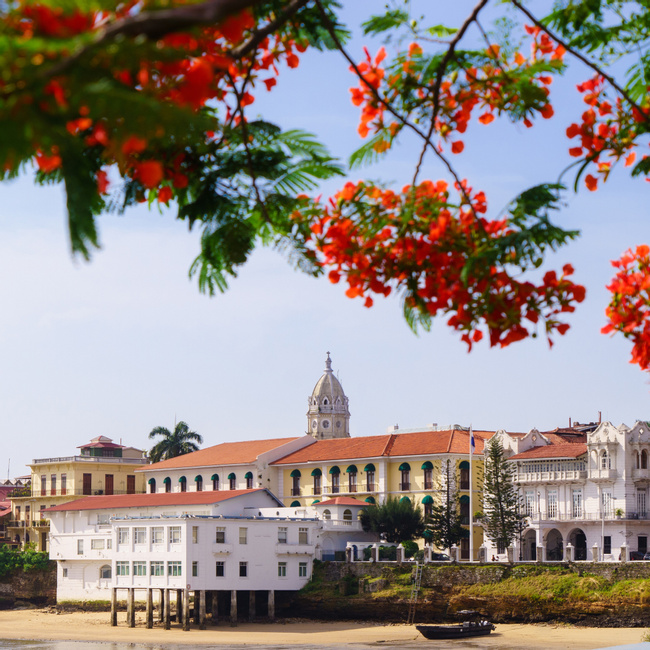- Travel Guides
Development and Society in Panama
In recent years, Panama has emerged as one of Central America’s most important players. Its economy is growing at a steady rate (largely due to a boom in construction) and its people are reasonably healthy and educated. Within Panama City, skyscrapers and chic new restaurants seem to pop up overnight. The growth is significantly slower further from the city, but some people are looking to change that and develop the country’s coastal and mountainous areas.

Sunny Climate & Outlook
Travelers and retirees are becoming increasingly interested in Panama as a destination to live or visit — its sunny climate; cheap cost of living; lively, youthful, and diverse culture; and abundant natural resources are, no doubt, attractive. Roman Catholicism is the predominant religion — a relic from the nation's history when Spanish explorers displaced native ancient civilizations. Panama does an exceptional job of blending its ancient roots with modernity, however, environmental issues surrounding development are pressing. How Panama chooses to manage — and balance — economic growth with environmental protection will define its evolution over the coming decades.
Health & Well-Being
By and large, Panamanians enjoy good health. Clean drinking water (a legacy of the Panama Canal Company’s strict hygiene standards) is available to most people, and the number of disease-related illnesses is way down. In fact, there has not been a single report of yellow fever since 1974, of polio since 1972, of cholera since 1993, or of diphtheria since 1981. Panamanians have access to moderately healthy food, although most grocery stores still aren’t stocked with huge amounts of vegetables. The government provides public health care (there are private sector options as well) and runs a competent school system. All of these factors have led to a life expectancy of 78 years, on par with that of the U.S.
Government & Economy
Panama’s government and economy has posted GDP growth greater than 7 percent in recent years and, historically, has had low inflation rates. Much of the country’s boom is owed to construction projects, including the expansion of the Panama Canal and an urban metro system, both of which are marked for completion in 2014. The Colón Free Zone (the second-largest free-trade zone in the world) also brings in sizeable revenues, as does international banking in the country’s capital. The Panamanian government is courting businesses and developers with incentives such as waiving property taxes for investors. At the same time, the government is also promoting extensive mining, hydroelectric, and tourism projects across the country.
Many of these projects threaten conservation efforts. Roads are being built through forests, mangroves are being removed, and some farmers continue to use slash-and-burn agriculture.
Environmental Protection
Panama had little environmental policy until the 20th century. During this time the country began to witness the dramatic effects of environmental destruction and began to take steps to change. This included the creation of protected areas, the writing of environmental laws, and the establishment of environmental nonprofits. Panama’s 76 protected areas cover close to two million hectares (4,942,108 acres) of land, some 25 percent of Panama’s total area, and much of the water that borders its coastline. 13 of the protected areas are national or marine parks (as well as one international park), and the rest are made up of wildlife refuges, protected wetlands, and buffer forests. These are all relatively new — the country’s first national park, Parque Nacional Altos de Campana, was established in 1966, and all others have been created since then.
That said, the government does not always do a good job enforcing its laws and policies; some hunters and fishers still work within protected areas, and deforestation continues to be an issue. The country’s water resources — including its rivers and coastal areas — may also be in danger, as sewage and garbage are sometimes discarded directly into the ocean.
One hopes, however, that a new ethic of conservation is coming to Panama. The environmental movement has grown by leaps and bounds over the last thirty years, and there are a number of people working hard to promote sustainable development. Panama’s largest conservation group, the nonprofit Asociación Nacional para la Conservación de la Naturaleza (National Association for the Conservation of Nature), or ANCON, has pushed since 1985 for greater environmental protection.
An Unknown Future
Panama’s economic growth may either help or hinder its environment — and ultimately its own success as a nation. If developers choose to sacrifice important outdoor areas for the sake of a buck, the country will lose many of its valuable natural resources. At the same time, economic growth may also be the best tool that Panama has to address environmental concerns. Similar to Costa Rica, Panama may adopt a more eco-friendly perspective, choosing to match conservation efforts with tourism in a way that benefits both the local people and environment.
It's more than just having a good time or visiting beautiful places (although that's absolutely a part of it!), it's about being part of a unique experience that stays with you.



